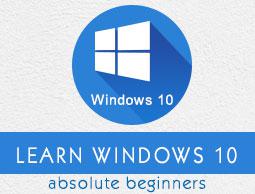Windows 10 Development - SQLite Database
In many applications, there are certain types of data, which have some sort of relationship to each other. These types of data, which are difficult to store in a file, can be stored in a database.
If you are familiar with the types of databases, such as SQL server or Oracle databases in any application, then it is very easy to understand SQLite database.
What is SQLite?
SQLite is a software library that implements a self-contained, server less, zero-configuration, transactional SQL database engine.
Important features are −
SQLite is the most widely deployed database engine in the world.
The source code for SQLite is Open source.
It has had a large impact on game and mobile application development, due to its portability and small footprint.
Advantages of SQLite
The following are the advantages of SQLite −
- It is a very lightweight database.
- It is platform independent and works on all platforms.
- It has a small memory footprint.
- It is reliable.
- No need for any setup and installation.
- It has no dependencies.
To use SQLite in your Universal Windows Platform (UWP) applications, you need to follow the steps given below.

- After selecting Extensions and Updates, the following window will open.
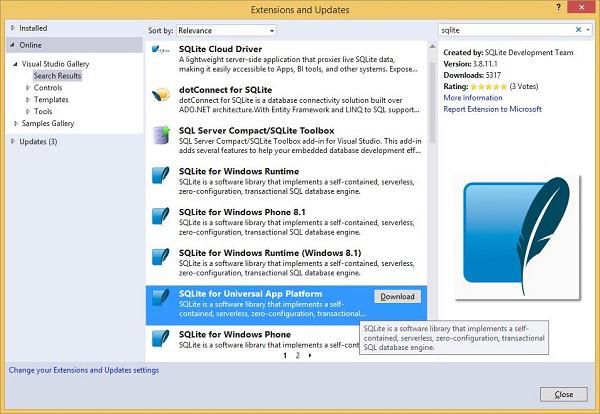
Now select the Online option and search for SQLite, from the left pane.
Download and Install SQLite for Universal App Platform.
Now, go to the Tools menu again and select NuGet Package Manager > Package Manager Console menu option as shown below.
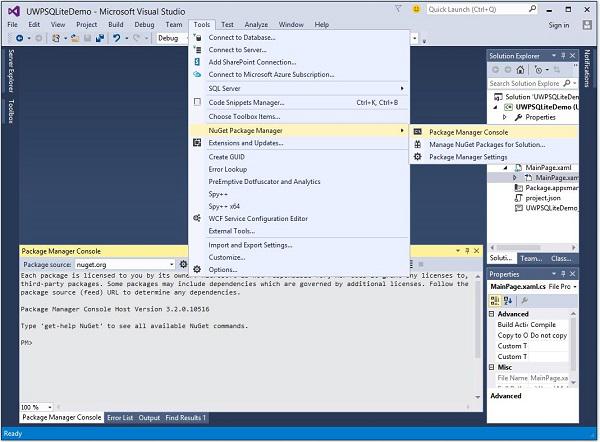
Install-Package SQLite.Net-PCL

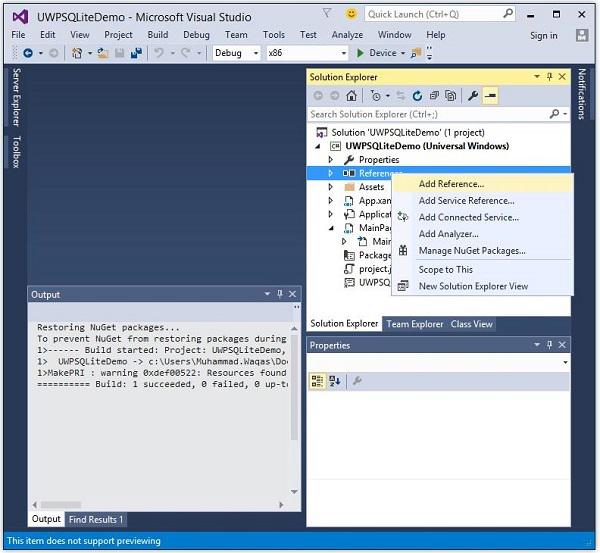
- The following dialog will open.
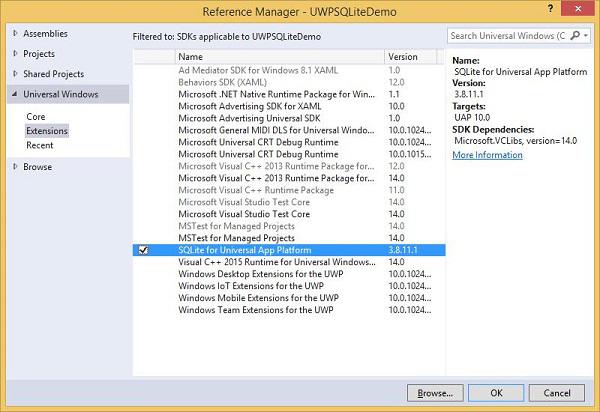
Select Extensions from the left pane under Universal Windows, check SQLite for Universal App Platform in the middle pane, and click Ok.
Now you are ready to go and use SQLite in your UWP applications.
You can create a database by using the following code.
string path = Path.Combine(Windows.Storage.ApplicationData.
Current.LocalFolder.Path, "db.sqlite");
SQLite.Net.SQLiteConnection conn = new SQLite.Net.SQLiteConnection(new
SQLite.Net.Platform.WinRT.SQLitePlatformWinRT(), path);
To create a table you need to call CreateTable method with table name object.
conn.CreateTable<Customer>();
You can insert the data into your table by using the following code.
conn.Insert(new Customer(){
Name = textBox.Text,
Age = textBox1.Text
});
Given below is the code to retrieve data from the table.
var query = conn.Table<Customer>();
string id = "";
string name = "";
string age = "";
foreach (var message in query) {
id = id + " " + message.Id;
name = name + " " + message.Name;
age = age + " " + message.Age;
}
Let us understand how to create a database, a table and how to insert and retrieve the data from the database with the help of a simple example. We will be adding Name and age and then we will retrieve the same data from the table. Given below is the XAML code in which different controls are added.
<Page
x:Class = "UWPSQLiteDemo.MainPage"
xmlns = "http://schemas.microsoft.com/winfx/2006/xaml/presentation"
xmlns:x = "http://schemas.microsoft.com/winfx/2006/xaml"
xmlns:local = "using:UWPSQLiteDemo"
xmlns:d = "http://schemas.microsoft.com/expression/blend/2008"
xmlns:mc = "http://schemas.openxmlformats.org/markup-compatibility/2006"
mc:Ignorable = "d">
<Grid Background = "{ThemeResource ApplicationPageBackgroundThemeBrush}" >
<Button x:Name = "Retrieve" Content = "Retrieve" HorizontalAlignment = "Left"
VerticalAlignment = "Top" Margin = "384,406,0,0"
Click = "Retrieve_Click"/>
<Button x:Name = "Add" Content = "Add" HorizontalAlignment = "Left"
VerticalAlignment = "Top" Margin = "291,406,0,0" Click = "Add_Click"/>
<TextBlock x:Name = "textBlock" HorizontalAlignment = "Left"
TextWrapping = "Wrap" Text = "Name" VerticalAlignment = "Top"
Margin = "233,280,0,0" Width = "52"/>
<TextBox x:Name = "textBox" HorizontalAlignment = "Left" TextWrapping = "Wrap"
VerticalAlignment = "Top" Margin = "289,274,0,0" Width = "370"/>
<TextBlock x:Name = "textBlock1" HorizontalAlignment = "Left"
TextWrapping = "Wrap" Text = "Age" VerticalAlignment = "Top"
Margin = "233,342,0,0" Width = "52"/>
<TextBox x:Name = "textBox1" HorizontalAlignment = "Left" TextWrapping = "Wrap"
VerticalAlignment = "Top" Margin = "289,336,0,0" Width = "191"/>
<TextBlock x:Name = "textBlock2" HorizontalAlignment = "Left"
Margin = "290,468,0,0" TextWrapping = "Wrap"
VerticalAlignment = "Top" Width = "324" Height = "131"/>
</Grid>
</Page>
Given below is the C# implementation for events and SQLite database.
using SQLite.Net.Attributes;
using System;
using System.Collections.Generic;
using System.IO;
using System.Linq;
using System.Runtime.InteropServices.WindowsRuntime;
using Windows.Foundation;
using Windows.Foundation.Collections;
using Windows.UI.Xaml;
using Windows.UI.Xaml.Controls;
using Windows.UI.Xaml.Controls.Primitives;
using Windows.UI.Xaml.Data;
using Windows.UI.Xaml.Input;
using Windows.UI.Xaml.Media;
using Windows.UI.Xaml.Navigation;
// The Blank Page item template is documented at
http://go.microsoft.com/fwlink/?LinkId=402352&clcid=0x409
namespace UWPSQLiteDemo {
/// <summary>
/// An empty page that can be used on its own or navigated to within a Frame.
/// </summary>
public sealed partial class MainPage : Page {
string path;
SQLite.Net.SQLiteConnection conn;
public MainPage(){
this.InitializeComponent();
path = Path.Combine(Windows.Storage.ApplicationData.Current.LocalFolder.Path,
"db.sqlite");
conn = new SQLite.Net.SQLiteConnection(new
SQLite.Net.Platform.WinRT.SQLitePlatformWinRT(), path);
conn.CreateTable<Customer>();
}
private void Retrieve_Click(object sender, RoutedEventArgs e) {
var query = conn.Table<Customer>();
string id = "";
string name = "";
string age = "";
foreach (var message in query) {
id = id + " " + message.Id;
name = name + " " + message.Name;
age = age + " " + message.Age;
}
textBlock2.Text = "ID: " + id + "\nName: " + name + "\nAge: " + age;
}
private void Add_Click(object sender, RoutedEventArgs e){
var s = conn.Insert(new Customer(){
Name = textBox.Text,
Age = textBox1.Text
});
}
}
public class Customer {
[PrimaryKey, AutoIncrement]
public int Id { get; set; }
public string Name { get; set; }
public string Age { get; set; }
}
}
When the above code is compiled and executed, you will see the following window.
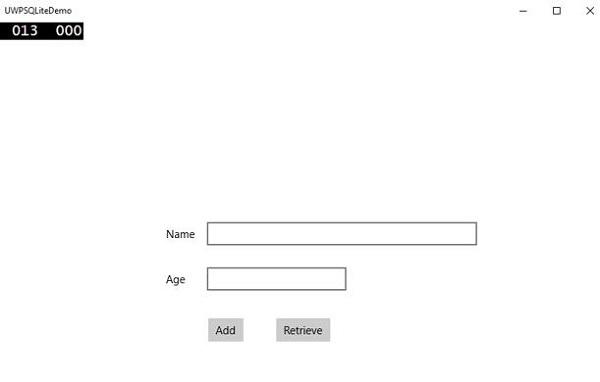
Enter the Name and Age and click the Add button.
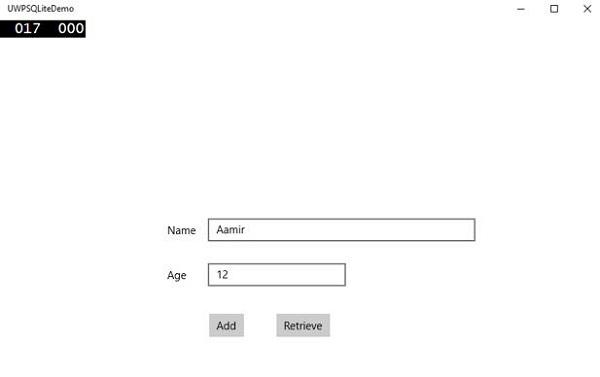
Now click on the Retrieve button. You will see the following data on the Text Block.
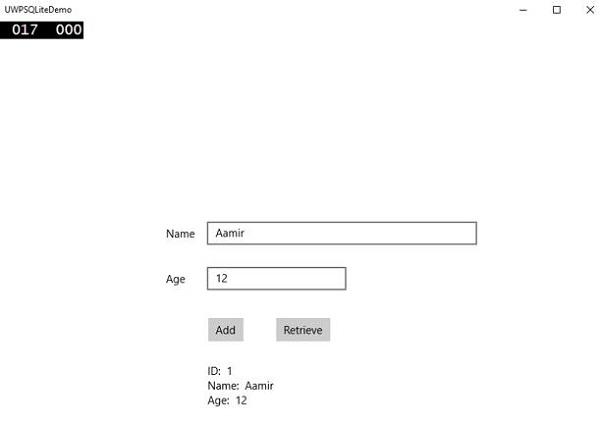
The ID field is a Primary Key and Auto Increment field, which is specified in the Customer class.
[PrimaryKey, AutoIncrement]
public int Id { get; set; }


